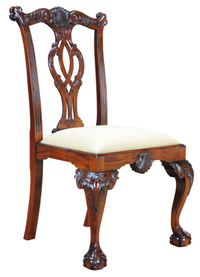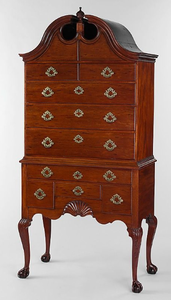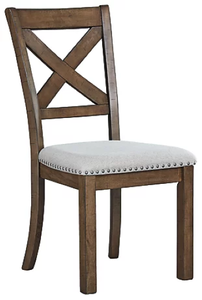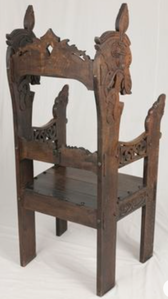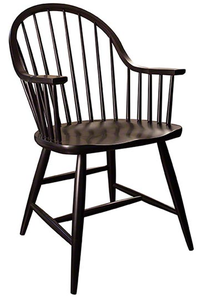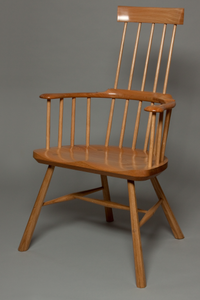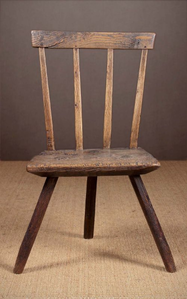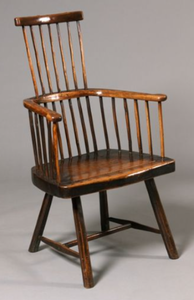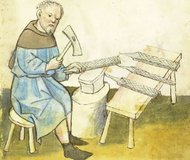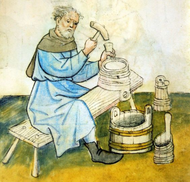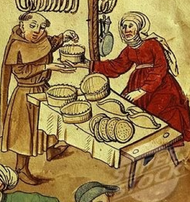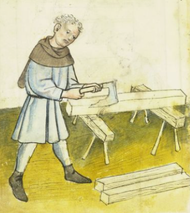Staked Stool Project: Difference between revisions
| Line 46: | Line 46: | ||
* '''''Good Work: The Chairmaking Life of John Brown''''' (Christopher Williams, Lost Art Press, 2020)<br /><br />This book was my first exposure to John Brown. He was a Welshman who plied various trades in his life until he settled on making stick chairs. His inspiration came from one he spotted in an antique shop and resolved to learn to build these chairs and sell them. Along the way over the next 30 years or so he basically revived the craft and inspired many other chairmakers around the world to take up this form. He wrote a short book (see below) and he wrote columns for the British woodworking magazine Goo Woodworking for many years. He was quite an interesting character. This book is by someone who was basically an apprentice who approached JB and asked to learn how to make these chairs and ended up spending the next decade working with him. The book covers their time together and walks you through the entire process including tool and stock selection. So, in that sense, it is a woodworking book, but there are no measured drawings in it. It's something of the philosophy of making these chairs that no two are alike. In fact, John Brown insisted that even when he tried, he couldn't do it. So you can use this book to make a chair, but you won't be following a recipe. I found the book very fascinating. It's what got me really interested in chairmaking in particular and led me to explore vernacular furniture. I read it in 2 days? I think. For a pretty thought-provoking book, that's very fast. | * '''''Good Work: The Chairmaking Life of John Brown''''' (Christopher Williams, Lost Art Press, 2020)<br /><br />This book was my first exposure to John Brown. He was a Welshman who plied various trades in his life until he settled on making stick chairs. His inspiration came from one he spotted in an antique shop and resolved to learn to build these chairs and sell them. Along the way over the next 30 years or so he basically revived the craft and inspired many other chairmakers around the world to take up this form. He wrote a short book (see below) and he wrote columns for the British woodworking magazine Goo Woodworking for many years. He was quite an interesting character. This book is by someone who was basically an apprentice who approached JB and asked to learn how to make these chairs and ended up spending the next decade working with him. The book covers their time together and walks you through the entire process including tool and stock selection. So, in that sense, it is a woodworking book, but there are no measured drawings in it. It's something of the philosophy of making these chairs that no two are alike. In fact, John Brown insisted that even when he tried, he couldn't do it. So you can use this book to make a chair, but you won't be following a recipe. I found the book very fascinating. It's what got me really interested in chairmaking in particular and led me to explore vernacular furniture. I read it in 2 days? I think. For a pretty thought-provoking book, that's very fast. | ||
* '''''The Welsh Stick Chair: A Visual Record''''' (Tim and Betsan Bowen, Pethe Press, 2020) <br /><br />A smallish book by the owners of one of the better known Welsh antique dealers. After decades in the business, the authors provide an interesting cross-section of the many variations on the Welsh Stick Chair. Over 100 color (or as they would say colour) photos. This will probably become good source material for designing chairs down the road.<br /><br /> | * '''''The Welsh Stick Chair: A Visual Record''''' (Tim and Betsan Bowen, Pethe Press, 2020) <br /><br />A smallish book by the owners of one of the better known Welsh antique dealers. After decades in the business, the authors provide an interesting cross-section of the many variations on the Welsh Stick Chair. Over 100 color (or as they would say colour) photos. This will probably become good source material for designing chairs down the road.<br /><br /> | ||
* '''''Welsh Stick Chairs''''' (John Brown, 1990, reprinted Lost Art Press 2020) <br /><br />Not sure how to classify this book. It is nominally a guide to building Welsh Stick Chairs, but it's not a how-to. You see all the steps, and it's probably enough if you're an experienced chair builder (I'm obviously not). It's also part philosophy. Kind of like some of James Krenov's books. It's not a long book, but you do get some insight into the notoriously cantankerous Welshman.<br /><br /> | * '''''Welsh Stick Chairs''''' (John Brown, 1990, reprinted Lost Art Press 2020) <br /><br />Not sure how to classify this book. It is nominally a guide to building Welsh Stick Chairs, but it's not a how-to. You see all the steps, and it's probably enough if you're an experienced chair builder (I'm obviously not). It's also part philosophy. Kind of like some of James Krenov's books. It's not a long book, but you do get some insight into the notoriously cantankerous Welshman.<br /><br /> | ||
Revision as of 19:31, 24 March 2021
Staked Furniture
I assume you are here because you're interested in the staked furniture I'm exploring or maybe just to see whatever it is I made. In any case, enjoy.
While I got my start producing furniture by making stuff to use at SCA events, I've grown interested in historical furniture in general. Turns out there were lots of interesting things made between the Renaissance and the advent of industrial furniture making (about 1850 in England and America).
Lately, I've read a lot about late 17th, 18th, and 19th Century vernacular furniture. This is the stuff the common people made and used. Because of the preservation bias of high-style items and what you see in museums and historic houses, many folks think the 18th Century is all mahogany high boys and cabriole feet. Sure, it was...for the well to do, that early 1%. For the rest of the folks, it was a little more mundane.
"Nice" chairs (like the Philadelphia side chair above) are built off the rear legs and most chairs are still made this way today. If the rear of the chair extends from the floor all the way to the crest rail (top), this is what I am talking about. That rear frame is the structural heart of the chair. You hang a seat frame off that and connect a couple of legs to that and you have a chair.
Staked furniture is different. Instead of building around the rear frame, the chair (or table or whatever) is built around a think plank. This is the seat in a chair or reinforced sections of the top on a table. Legs are mortised into the plank and the back/arms (if any) are also mortised into it, but separately from the legs. Examples of this style are Windsor chairs and their tough country cousins, the Welsh stick chair.
Staked furniture isn't limited to seating and it wasn't a "new" invention. A lot of medieval furniture is staked. Basically, all stools that depend on the seat for structure, many of the tables, including trestle tables are staked as well as all known workbenches from Roman times to the 15th Century.
dfgdf
Define Vernacular Furniture
Books Read
- Good Work: The Chairmaking Life of John Brown (Christopher Williams, Lost Art Press, 2020)
This book was my first exposure to John Brown. He was a Welshman who plied various trades in his life until he settled on making stick chairs. His inspiration came from one he spotted in an antique shop and resolved to learn to build these chairs and sell them. Along the way over the next 30 years or so he basically revived the craft and inspired many other chairmakers around the world to take up this form. He wrote a short book (see below) and he wrote columns for the British woodworking magazine Goo Woodworking for many years. He was quite an interesting character. This book is by someone who was basically an apprentice who approached JB and asked to learn how to make these chairs and ended up spending the next decade working with him. The book covers their time together and walks you through the entire process including tool and stock selection. So, in that sense, it is a woodworking book, but there are no measured drawings in it. It's something of the philosophy of making these chairs that no two are alike. In fact, John Brown insisted that even when he tried, he couldn't do it. So you can use this book to make a chair, but you won't be following a recipe. I found the book very fascinating. It's what got me really interested in chairmaking in particular and led me to explore vernacular furniture. I read it in 2 days? I think. For a pretty thought-provoking book, that's very fast. - The Welsh Stick Chair: A Visual Record (Tim and Betsan Bowen, Pethe Press, 2020)
A smallish book by the owners of one of the better known Welsh antique dealers. After decades in the business, the authors provide an interesting cross-section of the many variations on the Welsh Stick Chair. Over 100 color (or as they would say colour) photos. This will probably become good source material for designing chairs down the road. - Welsh Stick Chairs (John Brown, 1990, reprinted Lost Art Press 2020)
Not sure how to classify this book. It is nominally a guide to building Welsh Stick Chairs, but it's not a how-to. You see all the steps, and it's probably enough if you're an experienced chair builder (I'm obviously not). It's also part philosophy. Kind of like some of James Krenov's books. It's not a long book, but you do get some insight into the notoriously cantankerous Welshman. - The Anarchist’s Design Book Expanded Edition (Christopher Schwarz, Lost Art Press, 2019)
After 20 or so books, Chris Schwarz can put together a good how-to woodworking book. Lots of photos, a couple of drawings, a couple of smart-ass remarks, and just enough prose to tell you everything you need to know to actually build the projects. Add to that some contextual and philosophical interludes and you have a really excellent book on a sampling of staked and boarded vernacular furniture from the 15th to 21st Centuries.
At 644 pages, it covers a lot of ground and includes, much like Galbert's book below, all the tools and other information you need if you are just starting out. But this is by no means a beginner's book. The early projects are simple, designed to introduce skills you'll need to complete the more complex projects later on. This is the book I've been following in learning the whole complex angle things.
LAP offers most of their books in print and (DRM free) PDFs. This is one you'll want in PDF as well. I kept my old 2nd gen iPad Air when I got a new one (with actual battery life) and it lives down in the shop where being plugged in a lot isn't a liability. Much easier than working with printouts that fly around when you fire up O'l Breezy and get the table saw going. The only downside is that I don't have very distinct fingerprints at the best of times and in the shop, dry and rough wood means I pretty much have none, so unlocking the damn thing is a PITA. - Chairmaker’s Notebook (Peter Galbert, Lost Art Press, 2019)
I can't recommend this book highly enough. It may be the best-written and illustrated woodworking book ever. Maybe the best in any craft. Using just this book, you could select materials and tools and set about building a Windsor chair from a log. It has everything you need. There are two complete chair projects that between them give all the skills you need to make all the common Windsor forms. Also available separately are full-size drawings of all the components, especially useful for the turnings.
But it's not just that it's thorough. It's well written in an unpretentious style like you are speaking to a fellow woodworker who's enthusiastic to share his specialty with you. For the purposes of education, it's fortunate that Peter is a gifted illustrator. There are over 500 pencil sketch drawings in the book, at least one per page, all done by him. And, on the correct pages, a rarity in book layout. Really, it's awesome. Windsor chairs are not on my radar at this time, but I still enjoyed the book and learned some stuff anyway. - Windsor-Chair Making in America: From Craft Shop to Consumer (Nancy Evans, UPNE, 2005)
Nancy Evans is to American Windsor Chairs what Victor Chinnery is to English Oak Furniture. This book might weigh more than his 2nd Edition of Oak Furniture - The British Tradition. And it's actually the 3rd (and final) volume in her series on the form (the other ones are: American Windsor Chairs (1996) and American Windsor Furniture: Specialized Forms (1997)). Unfortunately, such a specialized, in-depth, and academically-oriented work did not have a large print run. It's like its predecessors, it's quite expensive when you can find it.
The first volume is an encyclopedic examination of the Windsor chair from its introduction into America from England in the 1730s with extensive documentation on the spread and variations of the form. At 744 pages, it has over 1000 illustrations and is 10 lbs. by itself (someone on Amazon gave it one star because it was too heavy). The second volume on specialized forms is only 256 pages as it just covers derived furniture like writing chairs and settees.
This 3rd volume, however, is back to 500 pages, hundreds of illustrations, and close to 10 lbs. But this is the one that appeals more to the furniture maker (or just woodworking enthusiast). You'll just need to read it at the table.
With exhaustive documentation, the author sets the context for chairmaking in Colonial and Federal America. Sections on: wood types and distribution, the types of craftsman making chairs including example apprenticeship papers and legal contracts, the socio-economic setting for this type of furniture, the role mechanization played in furniture making in the early-middle of the 19th Century, etc. It's pretty stunning in scope and thoroughness. Each chapter has hundreds, several hundreds of endnotes. The author scoured much primary source material putting this together. If you wanted to take a deep dive into some esoteric aspect of chairmaking in Colonial America, this is a pretty good place to start.
